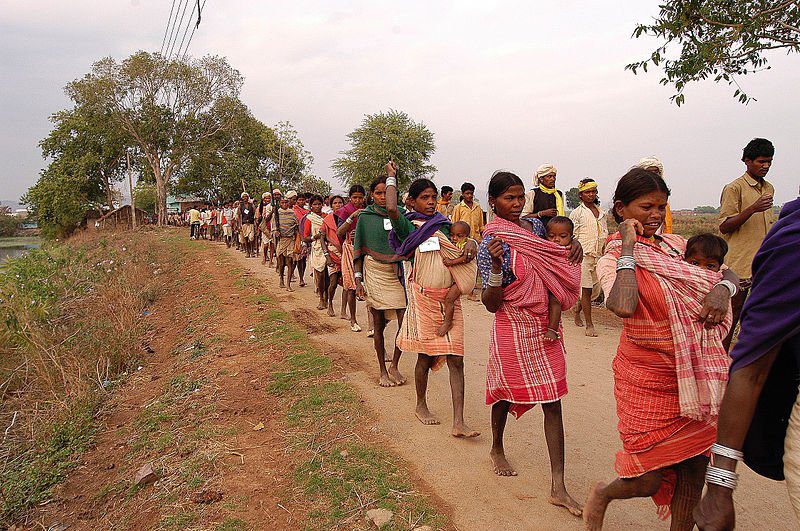Raghav is a fourth year asian studies/law student in his third year of hindi studies at the ANU. His interest in India and Indian affairs stems from his Indian heritage.
मध्य भारत के जंगलों में एक युद्ध है। लाखों आदिवासी लोग यह जंगलों में रहते हैं लेकिन इन जनलों में भारत के कोयले का ४०% और अरोबों डॉलर लौह अयस्क, चूना पत्थर, डोलोमाइत और बोक्सआइट भंडार शामिल हैं।विरोधी एक हाथ पर एक बलशाली अर्धसैनिक है जिसको भारत सरकार के पैसे और हथियार मिलते है । दूसरा हाथ पर गरीब आदिवासी माओवादी गोरिल्ला हैं।
यह पहली बार नहीं है कि यह संघर्ष हुआ है, अर्धसैनिक और माओवादी कई बार लड़े हैं।सबसे पहले ५० के दशक में टेलंगाना में, फिर ६० और ७० दशक में पश्चिम बंगाल, बिहार और आँध्र प्रदेश में और फिर एक बार फिर ८० दशक में आँध्र प्रदेश, बिहार और महाराष्ट्र में। हर बार जब वे माओवादियों से लड़ते थे तो उन्हें हार नहीं लगी थी, सरकार ने उन्हें खत्म कर दिया था। मगर हर बार वे पहले से मजबूत उभरे हैं। समकालीन संघर्ष छत्तीसगढ़, झारखंड, ओरिसा और पश्चिम बंगाल का खनिज अमीर जंगलों केंद्रित है: जो आधुनिक भारतीय अर्थव्यवस्था के ड्राइवर है।
आदिवासी लोगों का विद्रोह का लंबा इतिहास है, साँठल, मूँदस और गोंद सभी ब्रिटिश, ज़मींदार और धन उधारदाताओं के खिलाफ कई बार विद्रोह किया। वे सब विद्रोह असफल थे, लेकिन आदिवासी लोग असल में कभी नहीं हरे। भरतिया स्वतंत्र के बाद नक्सल्बरी में आदिवासी लोग पहली माओवादी विद्रोह में सहायक थे।तब से आदिवासी लोग पूरी तरह नक्सली राजनीति से लिपट गाए हैं ।
२००५ से छत्तीसगढ़, झारखंड, ओरिसा और पश्चिम बंगाल के सरकारों ने विदेशी और घरेलू निगमों के साथ अरबों डोलर के गुप्त सौदों हस्ताक्षर किए हैं इस्पात संयंत्रों, खानों, बिजली संयंत्रों और एल्यूमीनियम रिफाइनरी के लिए। इन परियोजनाओं के आगे बढ़ने के लिए आदिवासी लोगों को स्थानांतरित किया जाना चाहिए।इन परियोजनाओं द्वारा विस्थापित 24 मिलियन आदिवासी लोग माओवादी गोरिल्ला के लिए तैयार हैं।
भारतीय सरकार ने आदिवासी लोग जानबूझकर और व्यवस्थित रूप से हाशिए पर रख दिया है। भरतोया संविधान ने ब्रिटिश उपनिवेशवादी नीति लागू की और राज्य को आदिवासी भूमि के संरक्षक बनाया। इसने आदिवासी लोगों को अपने ही देश में अनधिकृत बना दिया और आदिवासी लोगों के जीवन के मार्ग को अपराध किया। निश्चित रूप से माओवादियों ने अत्याचार किये हैं । नक्सली सेना ने हजारों नागरिकों को मार डाला है। जन अदालत, माओ लोक पीठों के आधुनिक अवतार हैं। लेकिन आदिवासी लोग और क्या कर सकते हैं ?
***
500 Years of Rebellion
There is a war in the forests of central India. Millions of Adivasi people – India’s tribal people – live in these forests, which also contain 40 per cent of India’s coal, and trillions of dollars of iron ore, limestone, dolomite and bauxite reserves. The antagonists are, on the one hand, a massive paramilitary force backed by the money and weapons of the Indian Government, and on the other, the impoverished Adivasi Maoist guerrillas often referred to as Naxalites.
The flare-up of conflict between the two is not new; the paramilitaries and the Maoists have fought many times, and their battlefield has ranged across numerous Indian states. First in Telegana in the 50s, then West Bengal, Bihar and Andhra Pradesh in the 60s and 70s, and then once more in Andhra Pradesh, Bihar and Maharashtra in the 80s. With each of these incidents of conflict, the Maoists were not merely defeated; they were exterminated by the government. They have managed to re-emerge each time – the contemporary insurrection is focused on the mineral-rich forests of Chhattisgarh, Jharkhand, Orissa and West Bengal: the drivers of the modern Indian economy.
Adivasi people maintain a long history of insurrection. Various groups, such as the Santhals, the Mundas and the Gonds, have all rebelled several times – against the British, against the feudal landlords and against money lenders. Though these revolts were unsuccessful, following Indian independence, these Adivasi groups rose on the government’s agenda, most notably due to their instrumental role in the country’s first Maoist rebellion. This insurrection, taking place in Naxalbari (a small village in West Bengal, from which the term ‘Naxalite’ is derived), marked the point following which Adivasi people have remained intertwined with Naxalite politics.
Since 2005, the governments of Chhattisgarh, Jharkhand, Orissa and West Bengal have signed billions of dollars’ worth of secret deals with domestic and foreign corporations for steel and power plants, mines and aluminium refineries. In order for these deals to proceed, the tribal people who traditionally inhabit these lands must be moved. The 24 million Adivasi people displaced by these projects are the willing recruits for the Maoist guerrillas.
These events are merely one example of the manner in which the Indian Government has systematically marginalised Adivasi people. The Indian Constitution enforced British colonial policy and made the state the custodian of tribal land, which essentially transformed Adivasi people into squatters on their own land, and criminalised their way of life. Certainly, the Naxalites have committed atrocities; their forces have killed thousands of civilians, they are the Jan Adalat – the modern incarnation of Mao’s People’s Courts – but what are the alternatives?
We acknowledge the Ngunnawal and Ngambri people, who are the Traditional Custodians of the land on which Woroni, Woroni Radio and Woroni TV are created, edited, published, printed and distributed. We pay our respects to Elders past and present. We acknowledge that the name Woroni was taken from the Wadi Wadi Nation without permission, and we are striving to do better for future reconciliation.
